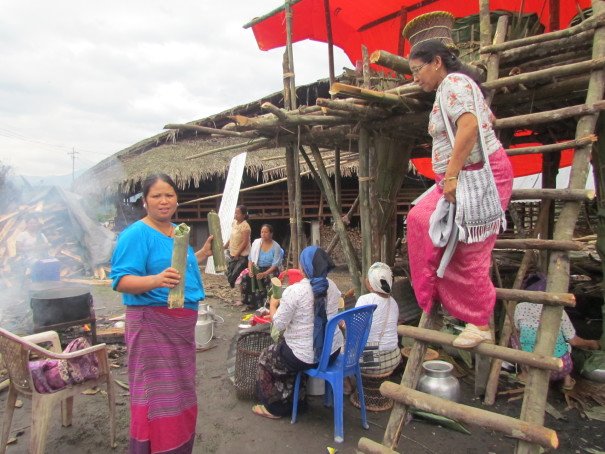
A Slight Buzz Comes in Handy During an Animal Sacrifice

A Slight Buzz Comes in Handy During an Animal Sacrifice
Apong in Arunachal Pradesh
I was standing a few feet away from an altar. Around it, small groups, each led by a shaman, were taking turns performing Popir, a traditional dance to invite spirits. Everyone was dressed in white. Suddenly, the crowd dispersed to allow a mithun, a large domestic bovine inside for a ceremonial sacrifice, and the chanting grew louder. My host, Karry, and a few others were taking turns explaining the rituals to me, but it was all too surreal. I held on tight to a bamboo tube filled with the local rice wine, Apong, and took a long swig. I can watch this, I told myself, but only with a slight buzz.
I was in Darka, a large village in central Arunachal Pradesh, a relatively remote and lesser-explored state tucked away in the northeastern region of India. We were surrounded by forested hills and the muddy Siyom river cut through rice paddy fields only a few yards away.
It was the first week of April and the indigenous Galo community, one of the most prominent tribes of the state, was celebrating their main festival, Mopin. A festival to please the spirits and seek good harvest and prosperity, Mopin is celebrated annually with dance and feasts by the locals. I had traveled with a few others to attend a “mega” version of the festival, which is celebrated once every three or five years by the entire village, including those who have left for work or marriage. The Galos work hard through the year, but come Mopin, they slow down to reward themselves with plates of meat and gallons of rice wine.
The previous day, we’d walked through the village and found it abuzz with preparation. On one side of the road, upon a raised bamboo platform, six women were busy preparing Apong. Long, conical bamboo baskets hung few inches above the ground. Two women sat on top of the platform, slowly stirring a fermented mass in the basket, while two others boiled water over a fire, which was then slowly poured over the contents. At the bottom, two women collected the brownish liquid seeping out of the baskets in large steel containers.
This was the final part of the brewing process that came after days of carefully fermenting the rice along with several other ingredients, including medicinal herbs. “The recipe has been passed across generations and the men know very little about it. They need us,” one of the women said with a giggle, and handed us small, hollow bamboo tubes used as mugs. The fresh brew was sweet, tangy, and very delicious.
A big ceremonial feast was organized and everyone was invited, but I had no appetite for lunch, and my fellow travelers and I started to make our way back to our homestay. On our way, we came upon a group of young men and women having their own celebration in one of the community halls, alternating between popular Galo songs and some of Michael Jackson’s hits. Before we knew it, we were ushered inside, our faces were smeared with rice, and a traditional bamboo headpiece was placed on my head like a crown.
Tubes of Apong were passed around. Many sips and a few pleasantries later, they dragged us to the dance floor. I was sure I looked quite silly and my Gale—the traditional wraparound skirt that Karry had draped around my hips that morning—was in danger of slipping off. But their enthusiasm was contagious. I gave in and danced, imitating their hand and hip movements. It was only much later, bursting with laughter, that we made our way home.